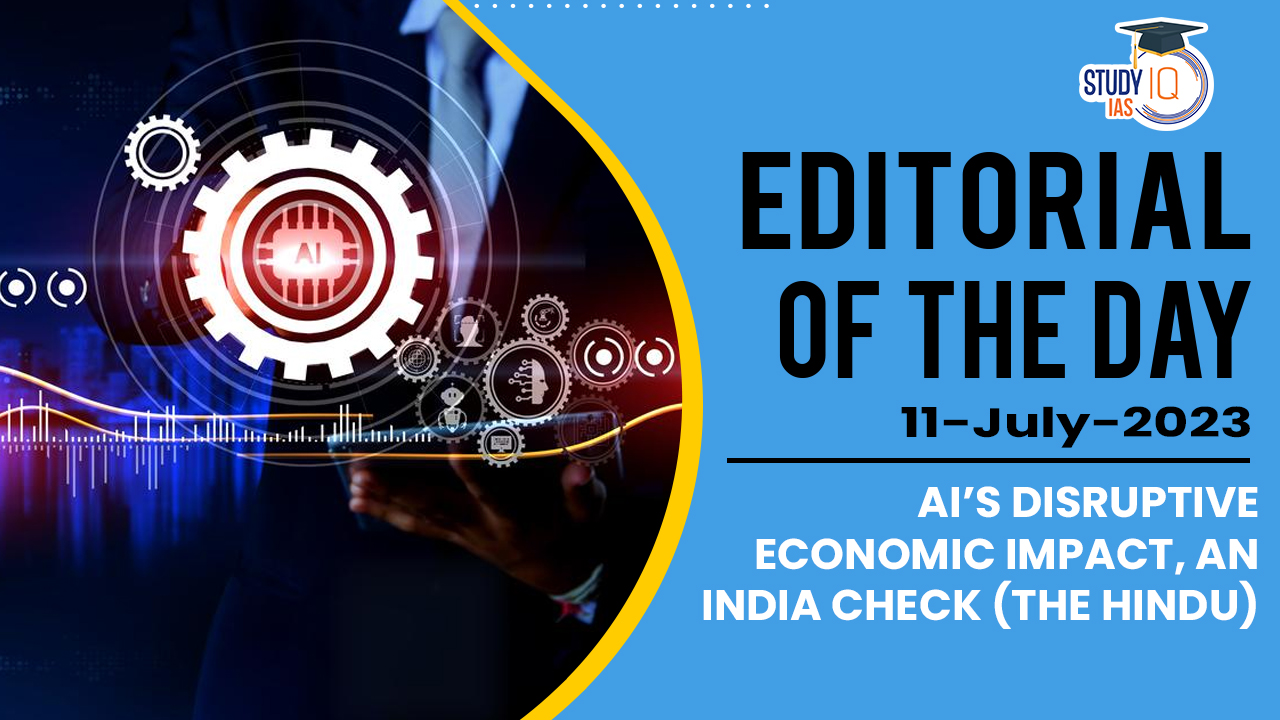Table of Contents
Context: The article is discussing the impact of Artificial Intelligence (AI) on various aspects of our lives and the global economy. It mentions how AI, specifically Large Language Models and Generative AI, has become more prominent and has generated interest worldwide. The article highlights the versatility of AI applications, such as authoring poems, generating pickup lines, and even passing difficult exams. It also mentions that initial ethical concerns regarding generative AI have diminished as users realize the productivity benefits they can gain from utilising such technology. The article further touches upon the ongoing debates surrounding AI’s impact on the workforce and economic growth, drawing parallels with the discussions that took place during the early days of the internet. Finally, it suggests that rather than focusing on heavy regulation, India should prioritise education and training in AI to leverage its potential in the global economy.
Background
About Artificial Intelligence (AI):
- It refers to the simulation of human intelligence in machines that are programmed to think like humans and mimic their actions.
- It may also be applied to any machine that exhibits traits associated with a human mind such as learning and problem-solving.
- It is based on the principle that human intelligence can be defined in a way that a machine can easily mimic it and execute tasks, from the most simple to those that are even more complex.
- The goals of artificial intelligence include computer-enhanced learning, reasoning, and perception.
- AI is being used today across different industries from finance to healthcare.

Decoding the Editorial
The article discusses the advantages and limitations of adopting Artificial Intelligence (AI).
Positive Aspects of AI Adoption:
- Increased productivity: AI tools have been shown to boost worker productivity by 14% in certain cases, as demonstrated by a study involving customer support agents. Employees using generative AI are likely to replace those who do not upskill, leading to overall improved productivity.
- Consumer satisfaction: AI adoption has resulted in better treatment of customer service agents and improved consumer satisfaction. This can contribute to increased customer loyalty and retention.
- Enhanced efficiency: According to a survey among employees of LinkedIn’s top 50 companies, almost 70% of respondents found that AI helped them be faster, smarter, and more productive. AI can automate repetitive tasks, streamline processes, and provide valuable insights for decision-making.
- Potential for future gains: Many experts anticipate even larger gains from AI in the next five years. While the current impact may be modest, restructuring business processes and increased investments can unlock AI’s full productivity potential.
- Economic growth: Research from various sources suggests positive impacts on global GDP due to AI adoption. Studies predict increases in global GDP ranging from 7% to 14% by 2030 as a result of ongoing advancements in AI. Generative AI alone has the potential to raise global GDP by 7% over a 10-year period.
- Innovation facilitation: Experts suggest that banning generative AI chatbots could hinder innovation. The ability of generative AI to break down communication barriers between humans and machines is seen as having significant positive macroeconomic effects.
Adverse impact on Employment:
- Labour replacement: AI technologies can automate both repetitive and creative tasks, potentially replacing the need for human labour in certain areas. This can result in job displacement, particularly affecting blue-collar workers and individuals with lower levels of education.
- Negative impact on workers: Research indicates that robot adoption and automation have negative effects on employment, wages, and the labour share. This is especially evident in industries experiencing rapid automation, leading to relative wage declines for worker groups specializing in routine tasks.
- Inequality and distributional concerns: Automation and AI can exacerbate wage inequality, particularly when productivity gains from automation are small. Distributional concerns arise as some workers benefit from AI adoption while others may face job insecurity or wage stagnation. Early adopters of AI may gain significant advantages, leading to a winner-takes-all scenario.
- Displacement of middle-class jobs: AI is more likely to displace middle-class, white-collar jobs compared to earlier technological advancements that shifted workers from lower-paid farm jobs to higher-paid factory floor jobs. This could lead to increased job disruption in those sectors.
- Technological divide and competition: AI may deepen the technological divide among firms, with early adopters gaining substantial competitive advantages. This could result in a scenario where a few companies or individuals dominate the market, potentially impacting employment opportunities.
Opportunities for India:
- Education and training: Given the potential impact of AI on employment, it is important for India to prioritize education and training in AI. Online education, which has gained wider acceptance after the COVID-19 pandemic, can be leveraged to provide learning opportunities in AI. By equipping its workforce with AI skills, India can take advantage of the demographic dividend and tap into the new opportunities that arise from AI adoption.
- Economic gains: While the PwC report suggests that China may experience the greatest economic gains from AI, India can still position itself to benefit from AI adoption. By investing in AI education and nurturing a skilled workforce, India can attract investments and leverage AI to drive productivity and economic growth.
- Cyber regulations: As AI permeates every aspect of the global economy, governments, including India, need to step up their cyber regulations to address new challenges posed by AI. This includes ensuring data privacy, addressing cybersecurity concerns, and establishing regulations to govern the responsible use of AI technologies.
- Balancing displacement and distributional effects: Governments may need to consider measures to mitigate the potential negative impacts of AI on employment and income distribution. This could involve implementing tax policies that balance the returns from capital and labour, reducing displacement effects and ensuring a more equitable distribution of benefits.
- Embracing advancements in AI: Rather than fearing a hypothetical scenario of a robot apocalypse, it is important for India to embrace the ever-growing advancements in AI. By staying abreast of the latest tools and technologies, India can position itself to adapt and thrive in the evolving landscape of AI.
Beyond the Editorial
India’s Initiatives for Generative AI:
- Launching the Generative AI Report: INDIAai, the Government of India’s National AI Portal, conducted numerous studies and hosted three roundtable discussions with some of the most prominent voices in Generative AI, AI Policy, AI Governance and Ethics, and academia to examine the impact, ethical and regulatory questions, and opportunities it brings to India.
- Joining the Global Partnership on Artificial Intelligence (GPAI): In 2020, India joined forces with 15 other countries to form the GPAI. The purpose of this alliance is to establish frameworks for the responsible utilization of emerging technologies.
- Fostering an AI ecosystem within the country: The Indian government has been dedicated to fostering an AI ecosystem within the country by investing in research and development, supporting startups and innovation hubs, creating AI policies and strategies, and promoting AI education and skilling.
- National Strategy for Artificial Intelligence: The Government has published the National Strategy for Artificial Intelligence with the objective of developing an ecosystem for the research and adoption of Artificial Intelligence.
- National Mission on Interdisciplinary Cyber-Physical Systems: Under this Mission, Technology Innovation Hubs (TIH) has been established on Artificial Intelligence and Machine Learning at the Indian Institute of Technology (IIT) Kharagpur, which aims to provide the state-of-the-art training and capacity building for the creation of next-generation scientists, engineers, technicians, and technocrats in the field of Artificial Intelligence.
- Artificial Intelligence Research, Analytics and Knowledge Assimilation Platform: It is a Cloud computing platform, aiming to make India a pioneer amongst emerging economies with regards to AI and transform sectors like education, health, agriculture, urbanization and mobility.


 Industrial Parks in India: Driving Manuf...
Industrial Parks in India: Driving Manuf...
 National Maritime Heritage Complex (NMHC...
National Maritime Heritage Complex (NMHC...
 Reforming Fertiliser Subsidy in India: N...
Reforming Fertiliser Subsidy in India: N...

























